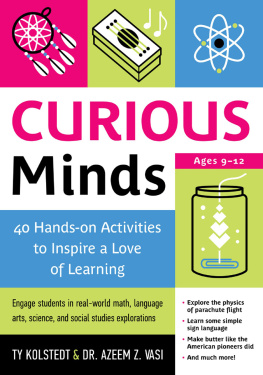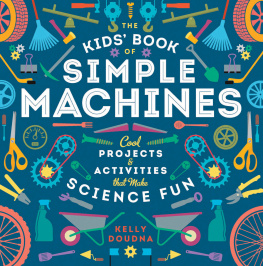
Copyright 2016 by Ty Kolstedt and Dr. Azeem Z. Vasi
All rights reserved
First edition
Published by Zephyr Press
An imprint of Chicago Review Press Incorporated
814 North Franklin Street
Chicago, Illinois 60610
ISBN 978-1-61373-150-5
Library of Congress Cataloging-in-Publication Data
Names: Kolstedt, Ty, author. | Vasi, Azeem Z., author.
Title: Curious minds : 40 hands-on activities to inspire a love of learning / Ty Kolstedt and Dr. Azeem Z. Vasi.
Description: First edition. | Chicago, Illinois : Zephyr Press, an imprint of Chicago Review Press Incorporated, [2015]
Identifiers: LCCN 2015029802 | ISBN 9781613731505
Subjects: LCSH: Activity programs in education. | Motivation in education.
Classification: LCC LB1027.25 .K655 2015 | DDC 371.3--dc23 LC record available at http://lccn.loc.gov/2015029802
Cover and interior design and illustrations: Andrew Brozyna, AJB Design, Inc.
Printed in the United States of America
5 4 3 2 1
For Cora, Zara, and Amir
CONTENTS
ACKNOWLEDGMENTS
We want to especially thank our agent, MaryAnn Kohl, for everything she has done for us. Her unwavering support, guidance, and belief in us and our project have helped us more than she could possibly know.
INTRODUCTION
Give the pupils something to do, not something to learn; and the doing is of such a nature as to demand thinking; learning naturally results.
John Dewey
W hile Deweys words would not seem out of place in a cutting-edge curriculum manual today, the father of the American education system actually wrote them in 1916. Deweys idea of learning by doing forms the bedrock of Curious Minds and our philosophy that children learn more when they are actively engaged with the material. Within this book, you will find 40 hands-on learning activities that promote critical thinking and authentic inquiry across a variety of subject areas. Our goal is to turn children into scientists, historians, mathematicians, and writers by getting them excited about gaining new knowledge about the world we live in. This book can be used by parents, teachers, or homeschoolers searching for new ways to get kids motivated about learning. These activities are designed to stimulate young minds, whether they are done in the kitchen or the classroom.
While we have included learning activities encompassing all four core academic areas (math, science, social studies, and language arts), we have also categorized them by specific content focus (physics, biology, chemistry, etc.). The organization of each learning activity is fairly straightforward. Each activity has:
A content and a primary skills focus:
Content Focus:
- Physics/Math
- Chemistry
- Language Arts
- Earth Science
- Social Studies
- Biology
Primary Skills Focus:
- Investigating and Classifying
- Design and Model
- Measuring and Observing
- Interpreting Data
- Historical Inquiry
- Exploring Connections
- Creative Expression
Mission Objective: This section introduces the topic and can include anything from a history of parachutes to an explanation of how oil is formed. This is the background knowledge and book learning part of the educational activity.
Learning the Lingo: To become a scientist, historian, or writer one must speak the language. Learning the Lingo introduces children to key vocabulary terms they will need to know to fully understand the specific learning activity.
Materials: What items are needed to complete the mission, or activity?
Plan of Attack: This is where things start to get interesting. The Plan of Attack outlines the step-by-step procedural directions of how to do the learning activity. In this step, children are transformed into ecologists examining soil pollution, economists analyzing interest rates, and writers creating colorful prose.
Take It to the Max! Once children have learned background information on the topic and have seen it in action, our hope is that we have merely whet their appetites. Take It to the Max! consists of independent extension ideas for children who are interested in delving further into a specific topic.
We thank you for purchasing Curious Minds and hope that children in your life find the learning activities engaging, enlightening, and fun!
I hear and I forget.
I see and I remember.
I do and I understand.
Confucius

PART I
PHYSICS & MATH
SHOOT! MINE DIDNT OPEN: THE SCIENCE OF PARACHUTES
Content Focus: Physics
Primary Skills Focus: Design and Model
Mission Objective: Jump into the basics of air resistance with a brief history of parachute design. Then, construct multiple styles of parachutes and test the merits of each design.

If you take a feather and pea and drop them from the same height, which one falls faster? The pea, right? One of the reasons this is the case is air resistance. In this mission you will become an expert in air resistance and design your own parachutes.
The idea of the parachute has been around for hundreds of years. While some say the ancient Chinese used a parachute-like device to jump from heights and perform acrobatics, Leonardo Da Vinci created the first known drawings of a modern-style parachute in 1483. His design was a four-sided pyramid made of wood and canvas. In June 2006 Adrian Nicholas glided to the ground safely using a parachute based on a sketch Da Vinci did of his parachute design. The builders of Nicholass parachute only used materials that would have been available to Da Vinci during his life. Isnt that cool?
Parachutes work because of air resistance. When a parachute is deployed (opened) there is drag, or air resistance, that pushes up the parachute and slows down the jumper. It is the parachutes light weight and large surface area that harness the power of air resistance. Its all about air molecules. A human without a parachute would fall fast because he or she would push through the air molecules very easily (like the pea). Air resistance is generated as the parachute runs into air molecules when hurling toward the Earth (like the feather). The force of all these air molecules pushing against the parachute slows its descent (drop).

After Da Vinci made his initial drawings in the 15th century, progress on the idea slowed and the parachute did not play a significant role until the early 20th century (or 1900s). Parachutes had lost the rigid frame and were now made of either nylon or silk. From the early 1900s to the 1960s parachutes had a circular design as shown here:
While these parachutes did get the traveler to the ground safely, the jumper didnt have the ability to steer them. The parafoil parachute design created in the 1960s included that improvement. The parafoil design is a rectangular-shaped wing capable of being steered to where its passenger wants to land. Did you know that some competition jumpers can land within inches of a target?
Next page








